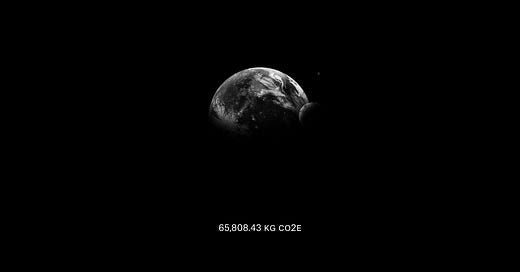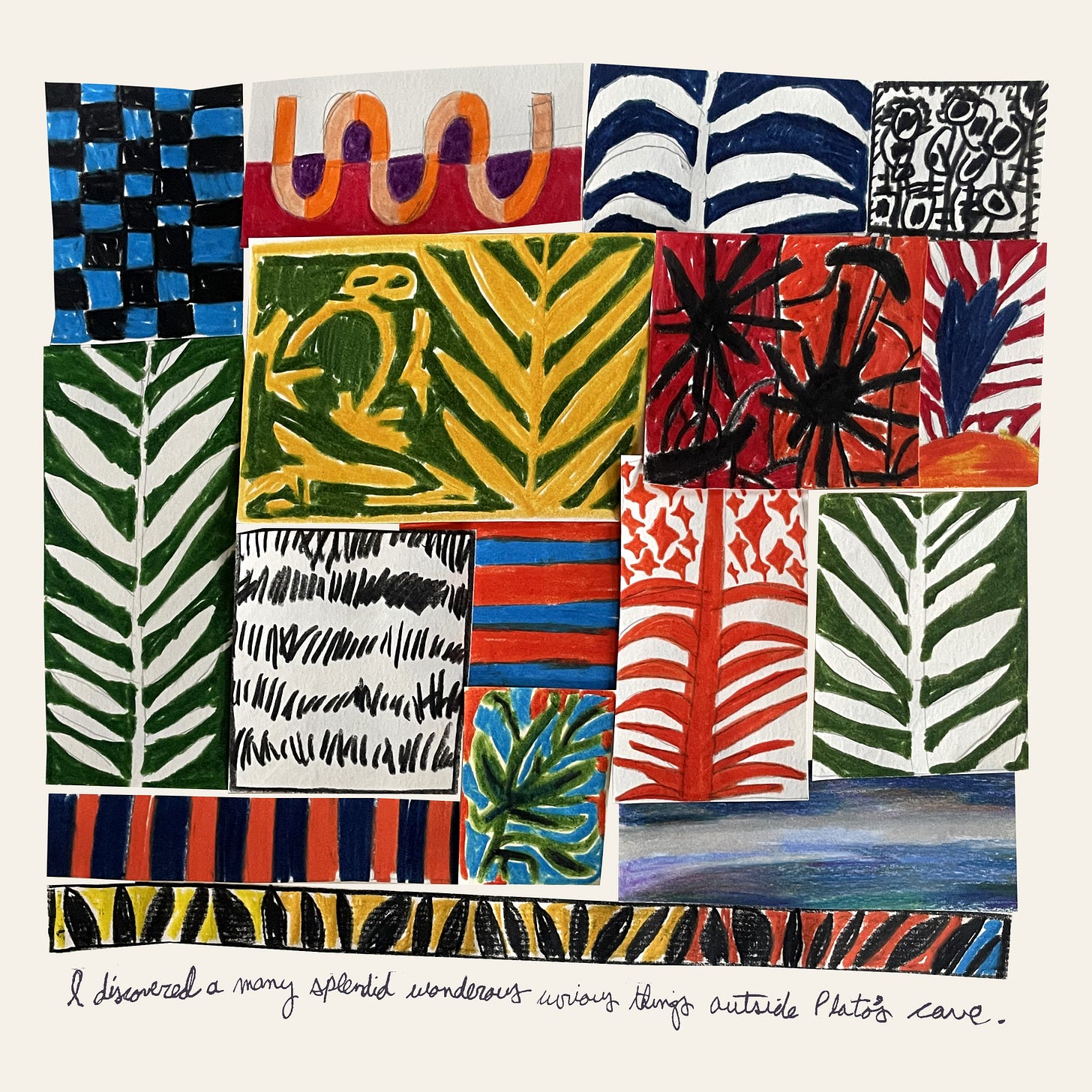garden3d 2022 Sustainability Report
Reviewing our impact as a growing creative business amid a changing climate.
Introduction
We’re pleased to release our fourth annual garden3d Sustainability Report. In this report, we’ll check in on our carbon footprint from the previous year, review the goals we been working towards, and make new commitments for the future. You can find our report from 2019 here, 2020 here, and 2021 here.
Our 2022 Sustainability Efforts in a Nutshell
Our studio size changed from 34 people in 2021 to 30 people at the end of 2022. Our goal has always been to remain a small-ish studio, and around this number feels like a good size for us.
Throughout last year, we purchased carbon offset credits that reflected 150% of our 2021 carbon footprint. Our 2021 carbon footprint was 39.13 metric tonnes CO₂e. We purchased offsets at an average price of $100 per tonne compared to the average market rate of $5-$15 per tonne CO₂e (a price range which we feel is way too low!). In total, we purchased offset credits for 189 tonnes of CO₂e for $6,547.85 (including Patch.io fees) (= 39.13 tonnes * 150% * $100/ tonne). We purchased offset credits in two categories: greenhouse gas emission avoidance and greenhouse gas emission removal.
We purchased 6 tonnes of CO₂e offset credits from the project Running Tide Kelp Sequestration (certificate here), whose mission is to improve ocean health, rebalance the carbon cycle, restore marine ecosystems, and revitalize coastal communities.
We also purchased 112 tonnes of CO₂e offset credits from Seneca Meadows Landfill Gas Capture (certificate here), a project that captures methane gas from a landfill in New York using underground gas wells, converting it into energy.
The third project we bought offset credits from was CarbonCure Concrete Mineralization who injects CO₂ into cement to make super-strong low-carbon concrete. We purchased 8 tonnes of CO₂e offset credits from them (receipt here).
Last but not least, we purchased 63 tonnes of CO2e offset credits from Grassroots Carbon Regenerative Grazing (receipt here). Their mission is to incentivize ranchers to adopt regenerative practices that create healthier soil, a process that offers the capacity to store 25% of all US CO₂ emissions each year.




In 2022, we flew the whole studio to Puerto Rico for a week-long team retreat. We were still working primarily remotely in 2022, and felt this retreat was important for team morale. However, it was also a significant portion of our carbon footprint for the year.
Seaborne, our sustainability consultancy, worked with some great clients to measure, reduce and mitigate their CO₂ emissions. The Seaborne business continues to grow — more details later in the report.
We continued to make use of the sustainability guidelines in our Moral Compass when deciding to take on new clients.
Garden3D's 2022 Climate Impact
For our studio carbon footprint calculations, we used the same process that we developed in 2019. Please refer to that Sustainability Report for a more detailed description of this methodology. We've captured this year's data by breaking out our emissions into the Greenhouse Gas Protocol (GHG) three scopes in a new tab in the spreadsheet below.
→ Check out our 2022 Calculations
As a quick reminder, this manual calculation method is based off the GHG Protocol's framework for assessing emission 'scopes.’
As with the previous years, we do not have any scope 1 emissions at garden3d. Scope 1 encompasses a company’s direct emissions such as running company vehicles, burning fuel for operations, or other such sources of direct emissions.
Our Scope 2 emissions stayed fairly consistent with 2021 levels as we were still working from home in 2022.
The majority of our carbon emissions as a firm fall in Scope 3, which is true of most firms. A major source of Scope 3 emissions came from our week-long company retreat in Puerto Rico. In addition to that trip, some employees started traveling again for client projects, and we also had more frequent social dinners when possible to nurture our studio culture and connection between employees. Lastly, as a software studio, the energy used for cloud computing is another major source of our scope 3 emissions.
Here are our final calculations as per the GHG Protocol:
Scope 1 (0%)
Scope 2 (2.34%)
Studio Electricity — 1,537.36 kg CO2e
Total Scope 2 Emissions = 1,537.36 kg CO2e
Scope 3 (97.66%)
Laptops — 2,383.10 kg CO2e
Cloud Computing & Web Hosting — 6,939 kg CO2e
Privately owned vehicles for Employee Commuting — 327.97 kg CO2e
Other Employee Commuting — 10.2 kg CO2e
Business Travel - Flights — 36,010.70 kg CO2e
Miscellaneous (Studio Materials, Meals, Hotels, Phone, and more) — 18,600 kg CO2e
Total Scope 3 Emissions = 64,271.07 kg CO2e
Total Carbon Footprint Emission for 2022 = 65,808.43 kg CO2e
In comparison to 2021, where our total carbon footprint was 39.19 metric tons CO2e, our total in 2022 increased by 67.93%. Given that our employee headcount decreased in 2022, this means that our carbon footprint per employee increased significantly last year. Our 2021 carbon footprint per employee was 1,150.82 kg CO2e, and our carbon footprint per employee in 2022 increased by 90.62% to a total rate of 2,193.61 kg CO2e per person.
This increase was primarily due to our company retreat to Puerto Rico, and flights for business trips to work with clients in-person. We also continued to encourage social dinners and hangs among employees to support studio culture.
As for reduction measures, we’re expecting our travel emissions will decrease in 2023. This year, we signed a lease on a new studio space in Chinatown, NYC, and have hosted our company retreat there. Because the majority of our employees live in New York, fewer people had to fly in and stay in hotels for this year’s retreat.
Offsetting Our 2022 Carbon Footprint
As with last year, we will purchase carbon offset credits at an average rate greater than $100 per tonne of CO2e removed or avoided to offset our 2022 greenhouse gas emissions. As our total carbon footprint for 2022 was 65.81 metric tons CO2e, that comes out to a cost of $6,581. In order to distribute our positive impact, we’ll be spending that budget over the next six months with greenhouse gas avoidance and removal projects that we find compelling. In next year’s sustainability report, we will share which offsets we purchase, the amount, and the reason why we’ve chosen the specific projects.
Beyond Offsets & Looking Ahead
Client Selection Framework
Through economic ups and downs, we consistently follow our Moral Compass when vetting client work for the studios in Garden3D. Within the sustainability category of our Moral Compass, we’ve established that we won't work with:
Hyper-consumerist products (like fashion, cosmetics & beauty products) that can’t show a valid sustainability initiative.
Hype- or desire-driven industries that survive on short, focused bursts of (mass-produced) cycles to sustain the business.
Products that claim a level of sustainability, but obviously undermine it, i.e. obvious greenwashing.
“Premium mediocre” products (cheap, mass produced) where the only value or innovation to the category is aesthetics or branding.
Seaborne — Our Sustainability Consultancy
Seaborne, our sustainability consultancy, is dedicated to sustainability strategy and accounting work. Across our studios, we’ve found that clients want to implement meaningful sustainability efforts yet lack the time or skills to take on this work themselves. That’s the challenge and need that Seaborne meets!
We’re currently working on creating a partner network program with like-minded studios, who also want to ensure their clients invest in sustainability commitments. We have created a marketing brief and training manual for our partnering studios to easily understand what Seaborne is, and all the benefits of investing in sustainability work. If you’re interested in joining the partner program or learning more, please reach out to Isabel and Maddy, or you can schedule a time with us here and we’d be happy to tell you more about our work and Seaborne!
We continue to release essays and original research on Substack defining our work and point of view. Our most recent research piece, “Substantive Sustainability Get More Clicks” tests the hypothesis that doing substantive sustainability work and communicating it to customers is good for our clients’ businesses. Our team developed an ad campaign for milli mylk, a subscription-based plant mylk company, to answer the questions:
Does including science-backed sustainability messaging in online ads lead to higher click through rates when compared to the same ads without any sustainability language?
How about when compared to ads that use greenwashing language? Does our rigorous and transparent approach to sustainability resonate differently with potential customers?
We tested this campaign on Facebook and Instagram, and found that, indeed, for audiences ages 25 - 54, our substantive sustainability messaging in product ads produces a significantly higher Click Through Rate (CTR) against both greenwashing and generic approaches to messaging.
Checking In On Our 2022 Goals
In 2022, we set the following goals:
We’ll be working to pull back on some of our unnecessary cloud computing usage this year, as those emissions have grown in recent years.
How we’re doing: Over the last year, we’ve been shutting down old servers that were running without much usage, and consolidating away from Digital Ocean for the most part. We’re expecting that in ~18 months or so, the majority of our cloud computing cost will be coming from Vercel, which we understand to be backed primarily by AWS (who, despite their bad image, are continually innovating the sustainability space).
We’re working to keep growing Seaborne’s reputation this year! We’ve recently signed on more clients, so we’re experiencing an increased demand for this type of service.
How we’re doing: Seaborne continued to work with great clients (The Light Phone II, Free Rain, Milli Mylk) in 2022, and we’ve created case studies for some of the work we produced. Seaborne currently has capacity for new sustainability projects in 2023, so get in touch if you think we can help.
Through Seaborne, we’re committed to continue to select one client a year to do a pro-bono sustainability analysis reporting for.
How we’re doing: In 2022, we worked with our long-term client Milli Mylk, and did a pro-bono sustainability analysis and reporting project for them. We then helped them tell their unique sustainability story by designing and developing an Impact page for Milli Mylk.
We will be releasing two essays on our Substack soon, discussing how organizations like ours can have impact beyond purchasing offsets.
How we’re doing: We released two articles (Greenwashing Certified™ &
Substantive Sustainability) as a two-part series last year outlining our perspective on how businesses can start to take substantive action in response to climate change. In Part 1, we call out corporate sustainability's shortcomings. In Part 2, we outline how to build corporate climate programs that are effective and resonant. We care a lot about the conversations that these essays advance, and have more posts in the works that will be released the next few months.
We’ll continue to offer a 10% rebate to any project or client (across all garden3d studios) that can show a meaningful, substantive sustainability initiative (or commit to working with Seaborne to build one).
How we’re doing: We continue to offer this 10% rebate, and clients made use of this rebate in 2022.
Our 2023 Goals
In January 2023, we signed a lease on a new studio space in Chinatown, NYC. The carbon footprint of this space will be included in next year’s report.
A big goal of ours is continuing to grow Seaborne — we’re working on creating even more alignment across our studios as well as a partner program to create a stronger positioning, and grow further. Get in touch if you’d like to learn more about working with Seaborne.
Seaborne and Index are finding new ways to include the community in conversations about climate. On October 19, we’ll be co-hosting a Collective Reading of A Planet to Win: Why We Need a Green New Deal, free and open to the public. Sign up and follow along for more!
We will continue to release essays on our Substack that expand and share our perspectives on corporate environmental responsibility, to stimulate thoughtful conversations in this space.
We’ll continue to offer a 10% rebate to any project or client (across all garden3d studios) that can show a meaningful, substantive sustainability initiative (or commit to working with Seaborne to build one).
Let’s keep chatting!
We aim to learn in community with others, and we will continue to be curious — help us learn!
Please reach out if you’d like to chat more, or if you’d like help doing the same for your company. Our team at Seaborne has the capabilities to help your team develop their own substantive sustainability initiatives and sustainability reports.
Corrections
We haven’t made any corrections to the article or calculations yet, but if you find misinformation or any miscalculations, please email us, and we’ll edit and list the corrections edits made here.










